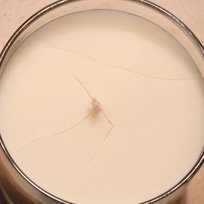It is perhaps the most frequently asked question we see online from candle makers: why do my candles crack?
7 “Why” are your homemade candles cracking
One of the most common questions asked by many candle makers online is “why does my candle crack?”? Here are the conclusions I came to after doing some research.
Candlemaking is perfect for those who always wanted to learn but didn’t have the time or energy to do so. It offers in-depth instructions on how to make a basic fireproof container, how to prepare different types of waxes and wicks, how to find the melting points of various materials, and much more!
The process of making candles can be a lot of fun, but it comes with challenges as well. When you pour at the wrong temperature, for example, you can wreak havoc. Depending on your mistakes, you may end up with sunk candles, tunnels or lack of combustion.
The most common trouble a novice candle maker encounters is cracks in their candles. Currently, this happens for a variety of reasons, so let’s talk about how to prevent or solve it.
Why are my homemade candles cracking?
In most cases, your candles crack for a variety of reasons, and that’s something that you can easily fix. Here we will examine the most common causes of your candles cracking on the surface.
The candle cooled too quickly:
The process of cooling your candles too fast is the prime cause for your candles to crack on the surface. We understand that sometimes you want to accelerate the process to make your candles faster.
Here is how to solve the problem:
You could just let it cool down a little bit more slowly :). It is important to keep your candles at room temperature; this means maintaining a constant temperature in the room. In other words, if it’s too cold (or humid) outside, it might affect the outcome. You can also keep it on top of a cooling rack or a towel.
If you freeze them:
It has been suggested that you put your candles in the freezer, but again this will cause cracks.
Here is how to solve the problem:
Keep your candles away from the freezer at all times. By putting them in the freezer, they will become a brittle and likely break.
A temperature of too high or too low:
In this situation, using a thermometer is crucial to ensuring the right temperature is maintained. You might end up with cracks on the surface if the pour is a bit too hot or cold.
Here is how to solve the problem:
The room temperature you are working in may require some testing, so you may have to adjust the heat by +/- 5° to find the perfect setting. You can usually achieve the best results by pouring at a slightly higher temperature.
Once the wax in the mold became too hard to handle, you filled the well with new wax:
If one fails, so will the other, and temperature and timing go hand in hand. Having cracked candles is the result of filling the well in the candle before the wax has completely cooled or when it has completely hardened.
Here is how to solve the problem:
One simple solution would be to pour a second time after the candle has warmed up a little.
An excessive amount of stirring or vigorous stirring:
By stirring too much or over stirring, you can create small air bubbles, which get trapped during the cooling process. The holes become smaller and smaller, leading to your candles bursting.
Here is how to solve the problem:
Stir as smoothly as you can while stirring. Stirring too fast has no benefit, so please do not do that. In the end, all you’ll get is a mess. It should be possible to completely avoid air bubbles at the right temperature and when stirring slowly.
There was an uneven cooling of your candles:
Candles that are kept more or less close together will cool down unevenly when they are cooled. The problem arises when Glass containers are placed too closely to each other, causing heat to be trapped on adjacent sides. It results in the sides of the jar cooling more slowly than the rest.
Here is how to solve the problem:
Keeping the distance between jars between 2″ – 3″ is recommended for safety’s sake. While your candles cool off, elevate them with a wire rack or a towel below it and cool them from the bottom up. Try to make the airflow under the candles more even to ensure even cooling.
Too much liquid is poured into containers too fast:
Too quickly pouring the wax causes air bubbles to get trapped inside and makes it harder for it to cool evenly.
Here is how to solve the problem:
Wax must be poured slowly, of course, and a pouring pot is the only way to achieve this. The price is not too high, and you can find them almost anywhere.
How should you handle cracked candles?
Imagine that you have made a large batch of candles and unfortunately the majority of them have large cracks. There is still time for you to save the world. Still, there is a way to save them.
Make use of a heat gun:
The melted surface will fill in cracks (or holes) left by the candle’s surface being melted. If there are air bubbles in the mixture, make sure to tap them out first.
Putting a finger on the container:
Earlier, I mentioned that if there are any air bubbles inside the container, you can tap it to remove them. Be careful not to tap too hard, you are working with glassware, so make sure you are not breaking it!
Melt some extra wax and save some for later:
Don’t forget to leave some candles for later when you pour your candles. The cracks will be filled out if needed and any other issues such as sink holes or uneven surfaces will be mitigated. The cracks can also be filled in with wax leftover from melting, poured on top of the surface, and filled in.
The process of coating containers or molds is as follows:
Coating the container or mold with coconut oil or another natural oil helps prevent the beeswax from sticking on the sides, which could lead to cracks.
Summary
The use of a thermometer when making homemade candles is indispensable, I understand. Rushing it can lead to cracks or other issues. It takes patience to make homemade candles. You should know that pouring wax at the appropriate temperature should be done slowly and steadily. Having cracks in your driveway is not a big deal if you fix them, but preventing them is definitely a better idea.

